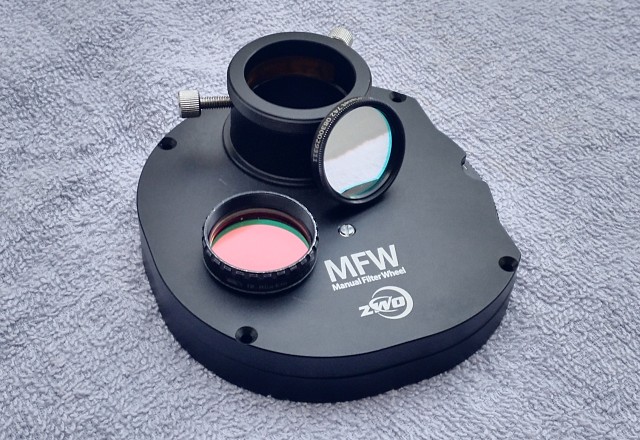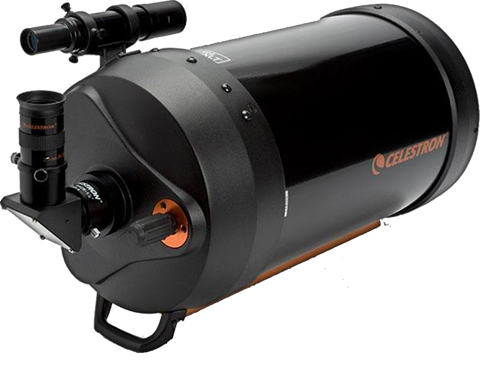Equipment
Telescope
In the interest of good resolution, a telescope with at least 5-inches (127mm) aperture, Newtonian or Cassegrain, will be fine. A Newtonian is most affordable and the 'fast' with typically F5 focal ratio sufficing with short exposure times, but is quite heavy therefore requiring a sturdy mount. More costly than Newtonians, Cassegrains come with a focal ratio of F10 and a long native focal length. A variation, the Maktsutov Cassegrain, has a slower focal ratio of around F12 to F15 and is said to produce sharp images. Cassegrains have a shorter tube and weigh less than comparable Newtonians. Owing to its design, the aperture of reflectors is obstructed by a secondary mirror. Consequently, a 6-inch scope is a little over true 5 inches. If you choose an 8-inch scope you will get true 6.5 to 7 inches depending on the size of the secondary mirror. Note that a Newtonian mirror has the larger area as compared with a Cassegrain of the same aperture. In Cassegrains a baffle goes through the center of the mirror.
Please be aware that large telescopes do not only collect more light but also way more air turbulences as compared with smaller telescopes. With 10 and more inches aperture you depend a lot on good seeing, but when seeing is really good the images will be highly rewarding. Telescopes from 5 to 8 inches, too, can produce remarkable images. Refractors can as well be used but are quite expensive with growing aperture. So-called "field flatteners" (for refractors) and "coma correctors" (for Newtonians) are not essential because the sensor of a 'planetary' camera is typically small.
Tracking Mount
The most important gear is an electronic equatorial mount capable of accurate tracking. The heavier the telescope the sturdier a mount is required. High magnifications typically required for lunar imaging call for accurate tracking. The mount should be specified for a payload of, say, 1.3 times the weight of your complete imaging gear.
Camera
A "planetary" CMOS astro-camera records uncompressed videos containing thousands of frames from which a certain percentage (typically the best 10% to 20%) are used for stacking. Available in color and monochrome, planetary cameras sport sensors up to full HD resolution (1920 x 1080 pixels), resulting in a narrow field of view which is desirable for imaging the Moon and the planets. Color cameras make it easy to image painlessly within short time. Monochrome cameras offer higher resolution and sharpness. In order to produce a color image with a monochrome camera a set of color filters is required significantly extending imaging and post-processing time. A filter set including wheel costs about the same as a color camera in that ownership of both a color and a monochrome camera is most efficient. Cameras containing the Sony IMX290 (mono) and IMX462 (color) sensors are ideal for our purpose.
Filters
Two types of filters are essentially required because a CMOS camera is sensitive to both visual and near infrared wavelengths. If used without filters images will look notably smeared with pastel colors. An infrared cut filter passes visual light only. It is indispensible for color photography. An infrared pass filter blocks visual light and can be used with both color and monochrome cameras while images are usually converted to gray scale because infrared is colorless. When the atmosphere is turbulent, an IR-pass filter can help reduce the effect of blurring.
IR-pass filters are available with kick-off wavelengths between about 600nm and 850nm. With increasing wavelength the camera's response drops in that filters with long wavelengths require longer exposure times while also trading resolution which drops at longer wavelengths. CMOS cameras containing the Sony IMX462 sensor are highly sensitive to infrared, therefore hardly compromising exposure time when using IR-pass filters up to 750nm. When frequently imaging in both wavelength domains, a (mechanical) filter wheel can help make imaging life easier.
Computer
Consider a laptop with SSD disk and powered USB-3.x port since mechanical hard disks are often too slow resulting in intermediate buffering of frames in memory, then saving the buffered frames to hard disk, a process which can significantly extend the time needed for writing a video file. Since you will be saving several Gigabytes per video file (ex.: 6000 frames, 8-bit depth = 12GB) the capacity of the hard disk should be generous, at least, say, 512 Gigabytes.
Software
- Capture: Please look for SharpCap or FireCapture or applications offered by camera manufacturers.
- Stacking: Please look for Autostakkert!3 which is the optimal choice.
- Sharpen: Although Autostakkert!3 can pre-sharpen, Registax6 is popular for its wavelet sharpening.
- Post-processing: GIMP, Photoshop or similar image processing applications.
- Mosaics: For image stitching, among other choices, MS-ICE is an accurate, simple-to-use application.
Other
table and a chair, power supply for the laptop and the telescope mount, an LED head light. When imaging in the field, a quick-cover for laptop and telescope (in case of a sudden rain shower). Food, drinks, medicine, first aid kit, etc. Else needed are seasonal accessories, such as a dew shield, lens heater (or a small hair dryer) and adequate clothing.
Example Gear
There is much more out there though...
If you cannot rule out giving up the hobby sooner or later, a low-cost entry equipment may be a reasonable start. A lot of people use a Sky-Watcher Mak127 (5-inch) on a AZ-GTi altaz mount (sold bundled) with a ZWO ASI224MC or QHY224C color camera. It is a low end camera but its sensitivity and image quality are everything else but low.
Provided you intend to enjoy the hobby for a long time you may consider an 8-inch Cassegrain on a solid mount with a camera containing the IMX290 (monochrome) or IMX462 (color) image sensor. Sufficient budget and endless motivation provided, go for an even larger Cassegrain telescope on a larger mount.
Equatorial mounts are offered by manufacturers such as Sky-Watcher, Celestron, iOptron, Orion, etc. Make sure the mount can burden the weight of the telescope plus imaging gear.
If you choose a Newtonian, you may wish to increase the focal length (magnification) using a barlow lens. A barlow of high optical quality is important since it adds glass to the optical path. Depending on the position within the optical train, a 2x barlow can act as a 3x barlow in that one barlow lens will suffice. Magnification beyond the resolution limit of the telescope does not yield further details.
Lunar imaging does not require a high-end laptop. With its fast SSD and USB, the Thinkpad E590 laptop, for instance, is ideal for video capture. If you own an elder laptop with HDD, you may wish to consider a planetary camera from "Player One" which has built-in 256MB buffer memory.





